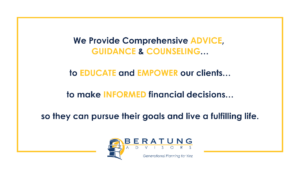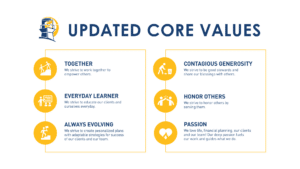What Can My Taxes Tell Me About My Retirement Contributions?
When the calendar turns over to a new year, there is a lot going on for most of us both personally and professionally. Usually, a big concern is when will your tax documents get to you so that you can file and get that chore over with. Perhaps, though, you should not view this as a chore, but as an opportunity to take a closer look at how you are saving for retirement.
When you are going through the process of completing your taxes, it is a perfect time to consider addressing your retirement account contributions. You include the amounts in your taxes, so it is a great reminder each year to take some time and evaluate what you are doing and the benefits you are getting from them.
Let’s take a look at some items I often discuss with my clients at this time of year:
- Your 401(k) Contributions
- Your IRA/Roth IRA Contributions
- Or possible changes to your Contribution Strategy
Your 401(k) Contributions
This is a subject that is very common in a financial planning meeting. I often discuss this with my clients in the first or second meeting as a basis for their long-term goals. Now, I am using the phrase ‘401(k)’ as a catch all for employer sponsored plans. You may have a 403(b), a 457, or a Thrift Savings Plan at your employer, but most of us just use the phrase 401(k) as it is the most well-known of these. Regardless, the need to evaluate what you are doing with the plan contributions remains the same.
You should consider several things when looking at these plans every year. Things such as:
- Am I contributing enough to my plan?
- You need to be looking at this in terms of now and into the future. If you are making minimal contributions now, you may need to begin increasing soon to accumulate the amount you will need to retire.
- Am I leaving free money on the table?
- Now, there is no such thing as ‘free money’, but the employer match in your retirement plan is pretty close.
- Often, clients might be either unaware of the percent their employer matches or are not familiar with what this actually means.
- Knowing this amount and making sure you are contributing at least the amount to get a full match from your employer can make a big difference in the long term.
- Where are my contributions going?
- You may have money going into the account, but if it is being placed in improper investments it might not be accomplishing your goals.
- If you make a substantial contribution and it all gets placed into low risk/low return investments, it might not grow as you intended. Take some time to look deeper into this each year to make sure you are invested properly.
As many of us have these employer sponsored plans, it is important to take some extra time and just do a quick check up on these items each year. You will find that often there is something you could be doing differently. Even in the years where there isn’t a need to change, at least you have peace of mind knowing you did your due diligence.
Your IRA/Roth IRA Contributions
When you are doing your taxes there is an important item to keep in mind. You can evaluate your situation and still make contributions to your Traditional IRA or Roth IRA accounts for the previous year all the way up until Tax Day.
There are many reasons for this provision in the tax code, but for sake of this blog I will not go into too much detail. Just think of this as the IRS allowing you to do your taxes, evaluate if contributions would be of benefit to you, and make the contribution to gain the benefit even though the year is over.
Some things to keep in mind with this evaluation are:
- How much can you contribute?
- You are allowed up to a maximum of $6,000 per year into your IRA accounts if you are under age 50, and $7,000 per year if you are over 50.
- How much is going into Traditional or Roth IRA?
- This is important if you have both forms of IRAs. The maximum per year is a total contribution and not the contribution per
- If you have a Traditional IRA and a Roth IRA your contribution of $6,000 has to be split among them, i.e. $4,000 to the Traditional and $2,000 to the Roth. You decide based on the tax evaluation, but keep in mind there are penalties if you over contribute.
- What are my benefits for making contributions?
- When doing your taxes, you should keep in mind that the benefits of contributions are based on how they are treated for tax purposes. You need to evaluate what benefits you are seeking by making the contribution.
- Traditional IRAs are tax-deferred, you deduct the contribution from your income now, and it has the potential to grow tax-deferred. So, you delay the tax you pay until retirement, and pay taxes upon withdrawal.
- Roth IRAs are different. You pay the taxes now, and you get the benefit of tax-free growth potential and tax-free withdrawal in retirement.
These are just 3 items to consider, but they are a great starting point for a conversation about Traditional and Roth IRAs as part of your financial plan. There is much more to evaluate when deciding if an IRA is appropriate for you and which form of IRA if appropriate for you. A discussion with a Financial Advisor and a financial plan can assist in the evaluation process.
Possible Changes to Your Contribution Strategy
When you are focused on your taxes and current financial situation it is a great time to look deeper at the overall benefits you are getting from all the contributions you are making. It’s also a good time to evaluate if it is time to make changes to how you are making these contributions.
- You might have only been focused on your 401(k) contributions and neglected possibly making IRA contributions.
- You might have overlooked the benefits of a Roth IRA strategy, and have been making Traditional IRA contributions for years without maximizing your benefits.
- There may have been a change in your tax situation this year and it makes things like converting your Traditional IRA to a Roth IRA possible.
There is so much your tax return can tell you, and these retirement account contributions are an important detail that can be evaluated with proper guidance. Taking the time to look at this in depth can help you to find the changes you need to make now that benefit you in the long run.
Next Steps
I always emphasize to clients that before you make a major change to how you make contributions or what you are contributing to you should evaluate what these mean for your situation. The best way to help make sure you are contributing properly to your retirement accounts is to have a comprehensive financial plan that specifically looks at these scenarios and guides you on your next steps.
If you would like to have a further conversation about your financial plan and how you could be making better decisions about your contributions give us a call at 412-357-2002.
This is meant for educational purposes only. It should not be considered investment advice, nor does it constitute a recommendation to take a particular course of action. LPL Financial and its representatives do not offer tax advice.
If you withdraw money from a traditional IRA before age 59½, your deductible contributions and earnings will be taxed as ordinary income. You may also be subject to a 10% penalty on early withdrawals.
Roth IRA contributions are subject to income limitations. You may take nontaxable withdrawals before age 59½ if the Roth IRA is held for at least five years and you meet certain distribution guidelines. Otherwise, an early withdrawal before age 59 ½ may be subject to taxes and a 10 percent federal tax penalty.
Please consult with a financial and tax professional regarding your personal situation prior to making any financial related decisions.

More Than a Logo: The Meaning Behind Beratung Advisors’ Brand
Our logo isn’t just about branding–it’s a constant reminder of who we are, what we do, and why we do it.

5 Smart Moves to Make When the Market Is Down
Here’s the truth—market downturns aren’t just something to survive… they’re something you can leverage.

Empowering Informed Financial Decisions: The Beratung Mission
At Beratung Advisors, we all have one job: to execute on our mission.

Why Property & Casualty Insurance Is a Critical Part of Your Financial Plan
An important part of financial planning—one that often gets overlooked—is your property and casualty insurance.

Refining Our Core Values: Making Them Clearer, Stronger, and More Actionable
At Beratung Advisors, our core values are the foundation of everything we do.

Make Your Vision Great Again: Why Clarity Wins
As leaders, we often assume our message is clear. We see the vision vividly, like a movie playing in our heads.

